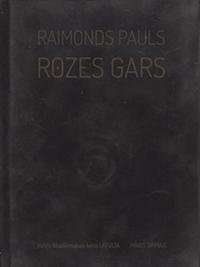The Latvian Radio Choir, led by conductors Kaspars Putniņš and Sigvards Kļava, has long been known worldwide as one of the premiere interpreters of modern choir music. They perform not only works by composers from many different countries, but are also innovators in the performance of experimental music of varied genres, and have collaborated with many different groups and ensembles.
One recent collaboration was with the Ensemble Sarband. Sarband, based out of Germany, is a group of musicians led by Bulgarian Vladimir Ivanoff, who also have a large diversity in their programs. According to their website, Sarband’s repertoire covers “from early Chinese music to Sami joiks, from Early Oriental Christian chant to the music of Gurdjieff” and often select works of a spiritual and sacred nature, and Ivanoff “illuminates the connecting threads between Orient and Occident, Judaism, Christianity and Islam”.
Together, the Latvian Radio Choir and Sarband recorded the album Canticum Canticorum, a collection of choir and vocal compositions that feature elements of Middle Eastern and Western music as well as traditional instruments. Many of the works include fragments from the Biblical text “Song of Solomon” or the “Song of Songs”.
On this recording, the Ensemble Sarband is made up of Ivanoff on percussion, Mustafa Dogan Dikmen (Turkey) on vocals, Efstratios Psaradellis (Greece) on the kemence, and Salah Eddin Maraqa (Jordan) on the qanun.
Vladimir Ivanoff, besides being the artistic director of Sarband and a percussionist, is also a composer, and three of his works are included on this collection. These are the “Sufi Readings No. 1 – Of Love and Union”, “No. 3 Suffering” and “No. 5 The Fragrance of Your Name”. All three are comparatively brief solo performances by the ensemble. The calm and peaceful instrumental “Of Love and Union” has plaintive melodies built upon a heartbeat-like effect on a drum, while “Suffering” features an almost wordless vocalize and is one of the albums few moments of turbulence, perhaps befitting its title. The wistful and perhaps even slightly sentimental “The Fragrance of Your Name” is perhaps the most mystical of the three works, and Sarband succeed in conjuring a an appropriate sonic interpretation of the text “your name is like perfume poured out.”
The collection also includes two works by Latvian composers. The first is Mārtiņš Viļums’ “Simeni khakhotam al-libekha” (Place me like a Seal over your Heart). The work features texts sung in Ancient Hebrew and Greek. The work is a treatise on love and sadness, ending on the note “et sheahavah nafshi reitem” (so I looked for him but did not find him). The Latvian Radio Choir tinges this composition with a broad array of emotions, from happiness to despair, and develops a very detailed performance, full of nuance and contrasts.
The second work is “Nada el layli” (Arabic for “Dewdrops at Night”) by Santa Ratniece. The comparatively lengthy work (thirteen and a half minutes), has the choir create a place and space for one to feel safe, as explained in the liner notes. Much like the work by Viļums, this is tinged with sadness, with the choir singing in a kind of soft moan for most of the song. Both the work by Ratniece, as well as the composition by Viļums, show the versatility and creativity of both composers, creating these distinctive works incorporating both the talents of the Latvian Radio Choir and Sarband.
As a whole, the album is very meditative and quiet, but due to its restrained nature may be difficult listening for some listeners, as the works are often very similar and flow into one another, making it at times difficult to determine when one work has ended and the next begun. Perhaps this was the goal – to have a cohesive meditative experience when listening to the album. One may have hoped for some more active, energetic sections, but those might have potentially disturbed the flow of this set of recordings. As the compositions are of a modern and experimental nature, there are periods of discordance with some harsh sounds, which may make the music sound formless to some listeners, so appreciating and enjoying this album will require attentive listening.
The ensemble Sarband and the Latvian Radio Choir, conducted by Kaspars Putniņš have created a rich tapestry of sounds for the meditative journey contained on Canticum Cantorum. With its blend of the spiritual and sacred, the modern and the ancient, Eastern and Western, and the harmonious and discordant, the collection of works included on the record create a very intimate and spiritual journey. The Latvian Radio Choir show again that they are adept interpreters of all kinds of music, and seamlessly blend together with Saraband in these spiritual works, with texts in many different languages, both ancient and modern. As a result, Canticum Cantorum is an engrossing musical meditation.
For further information, please visit the Latvian Radio Choir website and the Saraband website.
Canticum Canticorum
Latvian Radio Choir / Ensemble Sarband
Latvijas koncerti, LK-024, 20166
Track listing:
-
-
- A Sufi Reading Nr. 1 – Of Love and of Union – Vladimir Ivanoff
- Ah, ne guzelsin! – Toivo Tulev
- Lisaniki – Bushra El-Turk
- A Sufi Reading Nr. 3 – Suffering – Vladimir Ivanoff
- Simeni khakhotam al-libekha – Mārtiņš Viļums
- Nada el layli – Santa Ratniece
- TA Sufi Reading Nr. 5 – The Fragrance of Your Name – Vladimir Ivanoff
- Moces Salomonis – Lasse Thoresen
-




